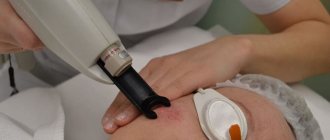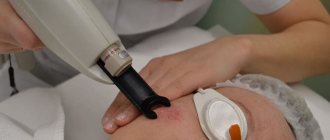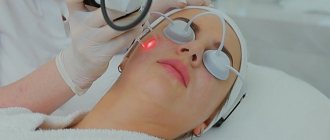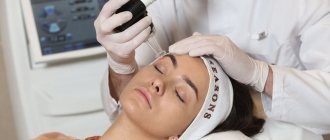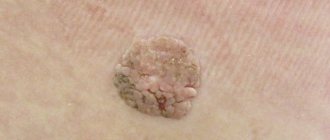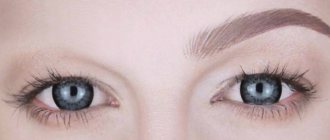| "Before and after" | Prices | Reviews | Doctors | Sign up |
Milia are dense formations in the superficial skin layer (epidermal cysts), in the form of white or yellowish nodules.
Milia rise above the surface of the skin as small white pimples from 0.5 to 2 mm. They are also called millet cysts, miliary cysts. Most often, milia are multiple and are located on the eyelids and under the eyes, around the eyes. They also occur in other areas of the face, less often on the body.
Methods for removing milia
The traditional way to get rid of white nodules on the face is mechanical cleansing. It can be performed using a needle or a special instrument called a curette.
Although this procedure is relatively low cost and available in most clinics, it has a number of disadvantages. In one session, no more than 10 formations are allowed to be removed in this way. Exceeding this norm will lead to disruption of the functioning of the sebaceous glands, as well as damage to the skin. After cleansing the face mechanically, wounds remain that, without proper care, will leave scars.
An effective way to combat milia is skin cleansing through electrocoagulation. To do this, the prepared area of skin is exposed to electric current. As a result, the structure of the formations is destroyed without harm to the tissues located near them. The process takes no more than 15 minutes. And although small wounds remain at the site of exposure, they heal quickly.
The method of laser removal of milia is currently considered the most common way to remove unsightly skin rashes. Its advantages lie in the ability to remove formations located quite deep in the epidermis. In this case, it is possible not only to destroy the structure of the nodule, but also to get rid of microorganisms that can cause inflammation in the area of manipulation.
Several types of lasers are used for the procedure. If a cosmetologist or dermatologist detects acne in an advanced stage, he will advise performing manipulations using an erbium laser. In addition to eliminating formations, it has a beneficial effect on the skin in the upper layers, stimulating the appearance of healthy cells in the future. At the same time, the face is polished and pathogenic microorganisms are eliminated, which becomes the prevention of skin diseases.
If the procedure involves intense exposure to the hair follicle located in the deeper layers of the epidermis, an alexandrite laser is used. It is preferable in cases where the area of influence is the eyelids and other particularly sensitive areas of the face.
Despite all its advantages, this method has limitations in application. It cannot be used in the treatment of people suffering from herpes virus infection, diseases of the endocrine system, diabetes mellitus, and oncology. Women who are pregnant or breastfeeding are not allowed to undergo laser therapy. If the client comes for the procedure with a fever or with signs of damage to the tumor, the session is postponed.
Causes of milia
The sebaceous glands are formed in the 3rd month of embryonic development, abundantly covering the skin of the fetus with waxy lubricant and function most actively in the first months of the child’s life and during puberty. The appearance of milia on the skin is associated with a violation of the regulation of sebum secretion and the process of exfoliation of keratinized epidermal cells.
Milia occur in patients with a thick form of oily seborrhea, characterized by hyperfunction of the sebaceous glands and changes in the chemical composition of sebum and creating a favorable background for the development of acne. Increased secretion of sebum and an increase in its viscosity due to a decrease in the amount of linoleic acid and an increase in the level of stearic acid contributes to intense keratinization (hyperkeratosis) in the hair follicle, its clogging with a mixture of thick sebum and horny masses with the formation of comedones. There are closed comedones - whiteheads (milia) and open comedones - blackheads (blackheads). Thick seborrhea is also characterized by the appearance of deep cysts of the sebaceous glands - atheromas and acne vulgaris.
The causes of increased secretion of the sebaceous glands are hormonal imbalance (high levels of androgens), excessive sensitivity of the sebaceous glands to hormonal effects, dysfunction of the autonomic nervous system, gastrointestinal diseases, hypovitaminosis, improper skin care, and nutritional errors. Excessive consumption of fatty, spicy, smoked, canned foods and sweets leads to excessive stress on the pancreas, liver and gallbladder dysfunction, impaired fat metabolism and increased cholesterol levels, which affects the functioning of the sebaceous glands. When using comedogenic cosmetics, excessive drying of the skin with various drugs and procedures, the regulation of natural sebum secretion is disrupted and the risk of developing milia increases.
There are primary milia, which appear spontaneously in the presence of a genetic predisposition to its formation, and secondary milia, which arise as a result of other pathologies. Secondary milia can form against the background of inflammatory and traumatic skin processes (along the edges of scars after abrasions, burns, mechanical peeling - dermabrasion, CO2 laser treatment, surgery), skin diseases (porphyria cutanea tarda, bullous pemphigoid, dystrophic form of epidermolysis bullosa, tuberculosis lupus, cutaneous sarcoidosis). Secondary milia sometimes regress spontaneously. There are family cases of a combination of milia in men with benign tumors of the skin appendages - cystic glandular trichoepithelioma and cylindroma.
How to prepare for removal
Although sometimes milia can be removed from the face without assistance, most often you need to take action to get rid of them. First, it is advisable to identify the cause of facial skin problems. Eliminating it will be an important step for the procedure to be effective. When planning to remove milia surgically, you need to start preparing about a month in advance. To do this you need:
- refuse to visit baths and saunas;
- Avoid damaging the skin with peeling or other methods.
During this time, you must visit a dermatologist or cosmetologist. Having assessed the condition of the skin, the number, location, and depth of nodules, they will determine the course of treatment. If there are few formations on the face, one session will be enough. A large number of milia must be eliminated in several stages. The location of the nodules will largely determine the method of their removal. These conditions will determine how much the service will cost.
Features of the procedure
Infection of the wound during the procedure is impossible - the laser beam has hemostatic and wound-healing properties. Laser treatment does not affect areas of healthy skin. After removal, a healing wound with a dry crust remains at the site of the milia. The patient is advised not to disturb the damaged area. You cannot remove the crust, otherwise there is a risk of infection, which significantly increases the rehabilitation period. With proper care after the procedure, after 10-12 days the skin takes on a smooth and healthy appearance.
How is removal carried out?
Before starting the intervention, it is necessary to treat the face with antiseptic agents. This will prevent the possibility of infection getting into the wound. When removing milia mechanically, the pores will need to be steamed. When exposed to laser, special glasses are worn to protect the eyes.
As soon as all preparatory activities are completed, the specialist begins the procedure. Either a puncture of the papule is carried out, followed by the extraction of its contents, or the neoplasm is cauterized with alternating current until a crust forms. Or laser treatment of milia. At the end of exposure, the skin is treated with anti-inflammatory agents.
A particularly difficult part of the procedure is the removal of nodules that have formed on the eyelid. Since an incorrectly chosen technique can affect the condition of the eye and visual acuity, in addition to the cosmetologist, a dermatologist and an ophthalmologist take part in determining the course of treatment. In order not to damage the delicate skin, a non-contact radio wave scalpel or laser is used to work on this area of the body. If the formations are located in the upper layers of the epidermis, a light peeling will be enough.
Why should milia be classified as a separate group?
Milia are intradermal cysts filled with keratin masses.
Keratin is a protein that is part of the upper layers of skin, hair and nail plates.
If you think that you have milia, then specialists from the ATLANTIC Laser Surgery Center will help you confirm or refute your assumption.
Rice. 2. Multiple milia on the skin
Milia can affect anyone, any age, any gender, and any skin type. It should be noted that children are more prone to developing milia, but removal is usually not necessary.
Recovery period
The healing time of wounds after removal of milia is 7-10 days. After mechanical manipulation, it is necessary to provide wound care as prescribed by the doctor. When performing other types of interventions, it is strictly forbidden to rip off the resulting crusts. After the recovery period has expired, they will disappear on their own. Regardless of the method of removing nodules, the following requirements must be adhered to:
- during the recovery period, it is necessary to cancel plans for swimming in the sea or pool;
- During this time, you should avoid peeling;
- prolonged exposure to sunlight is also contraindicated.
To speed up the recovery period, a specialist will select a complex of ointments and creams. Therefore, it is worth listening to all his recommendations.
The price for such services in Moscow may vary depending on the level of the clinic or beauty salon. Therefore, it will be useful to find out in advance all the possible options for places where white nodules on the face or body are removed in order to choose the best one in terms of quality and cost. Medical centers that employ qualified specialists and have the necessary special equipment for milia removal are more trustworthy.
Primary sources of problems
Before going to the beauty salon, potential patients are asked to understand the reasons for the prosyanka. There are many factors for its occurrence, so several aspects often provoke a surge in a peculiar release of sebum.
Among the most common sources of the disease is excessive use of decorative cosmetics.
Moreover, it is not even so important how high quality the product turned out to be. It’s just that when the sebaceous glands are clogged with a thick layer of powder, foundation or any other tinting agent, the pores of the skin stop working normally.
Also, the reasons for unsightly covering the face with small wen are:
- incorrect functioning of some internal organs;
- improper diet;
- excessive use of thermal procedures.
The first point of the program affects malfunctions not only of the gastrointestinal tract, but also of the pancreas and liver. Either one body or all at once may cease to perform its duties. In this situation, trying to excise the tubercles with a laser will be a futile exercise. You will have to start treatment from the inside to remove the barrier to glowing, beautiful skin.
Abuse of junk food becomes a direct path to obesity. The deposition of excess sebum in milia works on an identical principle. When the daily menu contains an abundance of excessively salty, sweet, fried or smoked food, this will quickly affect a person’s appearance.
Tanning is no less dangerous. Moreover, we are talking not only about visiting a solarium, but also about a long stay on the beach during the hottest hours.
In adolescents and middle-aged women, hormonal changes become the primary source of difficulties. An equally common cause is toxic poisoning of the body from within, which occurs with prolonged methodical accumulation of toxins. Bad habits such as drinking alcoholic beverages and smoking also add to the risk of being affected by fat “grains”. People who suffer from increased dryness of the skin of the face should be especially careful. But the most important pillar for the development of lesions is insufficient skin hygiene. This applies to both the inability to choose normal skincare products and the habit of not washing off makeup before bed.
Milia on the face: photo
In the photo below you can see what milia look like on the face. They can appear not only on the face, but also on the eyelids, under the eyes, and on the nose.

